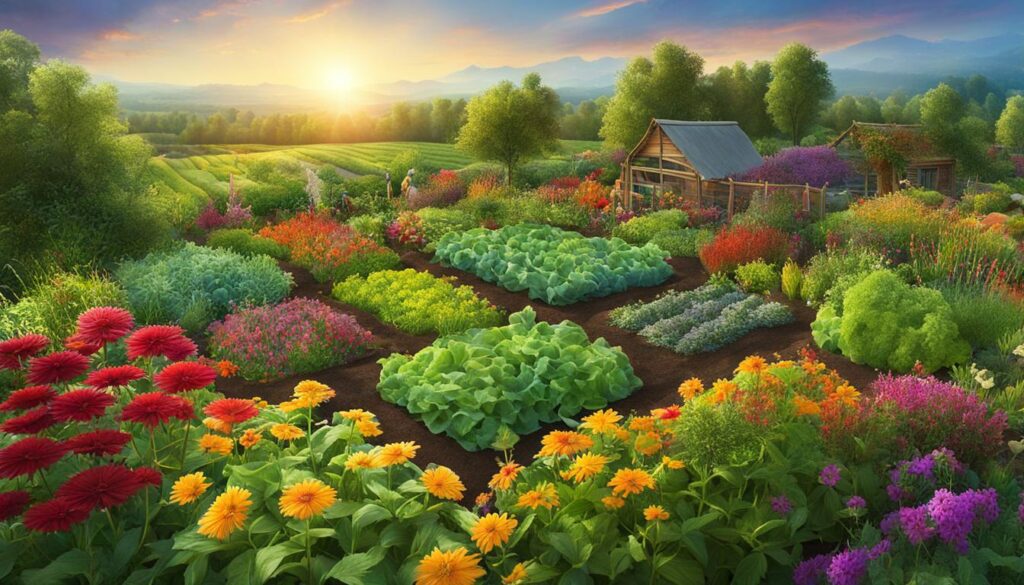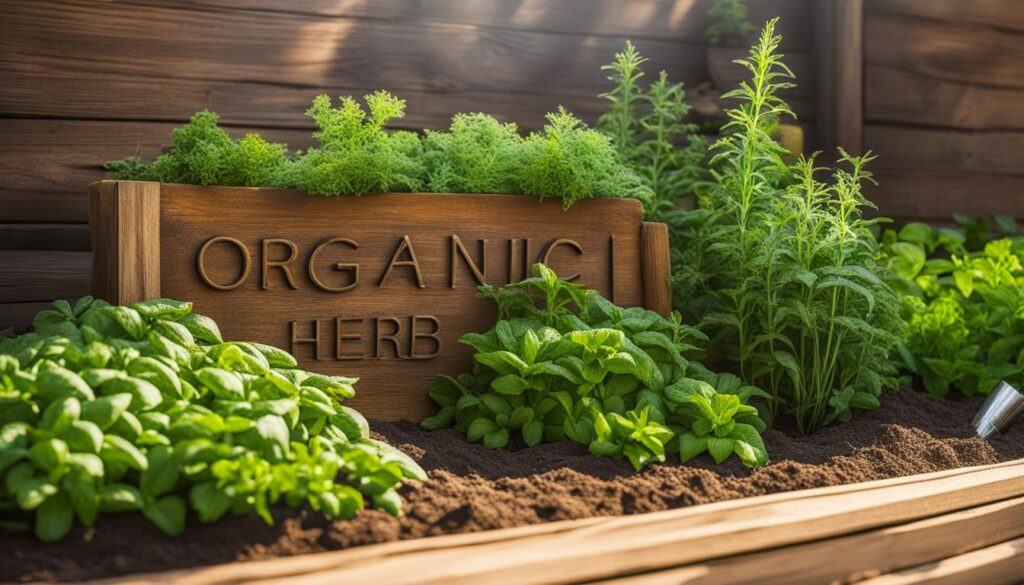The art of herbal cultivation techniques holds within it the power to unlock nature’s pharmacy and promote holistic health and wellness. As I delved into the world of sustainable farming methods and organic herb gardening, I discovered a fascinating community that truly masters the art of herbal cultivation. The Nalu people in Guinea-Bissau have a profound understanding of medicinal plants, utilizing specialized practices and methods that have been passed down through generations.
Key Takeaways
- Herbal cultivation techniques are essential for preserving traditional knowledge and promoting holistic health.
- The Nalu people in Guinea-Bissau have a deep understanding of medicinal plants and their uses.
- Sustainable farming methods and organic herb gardening play a vital role in maintaining the quality of medicinal herbs.
- Starting an herb garden requires careful planning and consideration of available resources and space.
- Creating a layout and selecting companion plants can enhance the growth and success of your herb garden.
The Importance of Herbal Medicine in Rural Contexts
In West African rural contexts, the collection and use of medicinal plants for pharmacological purposes are of great importance. Guinea-Bissau, in particular, relies heavily on the use of plants for medicinal purposes. Traditional medicinal systems in Guinea-Bissau are based on the use of plants, and various studies have been conducted to explore the botanical and pharmacological analysis of medicinal plants. The Nalu people, living in Guinea-Bissau, have a deep connection to nature and rely on traditional herbal farming techniques to support their community’s health and wellness.
Through natural farming practices, the Nalu people have developed effective herbal growing methods that prioritize sustainability and organic cultivation. These methods not only ensure the production of high-quality medicinal plants but also contribute to the preservation of traditional knowledge and the overall well-being of the community. By utilizing locally available resources and implementing holistic farming practices, the Nalu people demonstrate the potential for herbal medicine to thrive in rural contexts.
“Herbal farming techniques have been passed down through generations in our community. We believe in the power of nature and its ability to heal. Our sustainable farming methods not only benefit our physical health but also help us maintain a strong connection with our land and cultural heritage,” says Aminata, a Nalu healer.
Table: Benefits of Herbal Farming Techniques
| Benefits | Description |
|---|---|
| Promotes Sustainability | Natural farming practices minimize the use of synthetic chemicals, reducing environmental harm and promoting long-term ecological balance. |
| Preserves Traditional Knowledge | By relying on traditional herbal farming techniques, communities can preserve their cultural heritage and ensure the continuity of valuable ethnobotanical knowledge. |
| Produces High-Quality Medicinal Plants | Organic cultivation methods result in the production of potent and effective medicinal plants, free from harmful residues. |
| Enhances Community Well-being | The availability of locally grown herbal medicine supports the health and wellness of rural communities, reducing reliance on costly pharmaceuticals. |
By recognizing the importance of herbal medicine in rural contexts and embracing effective farming techniques, communities can not only improve their own well-being but also contribute to the broader movement towards sustainable and holistic healthcare. The Nalu people serve as a powerful example of the profound impact that herbal farming can have on individuals, communities, and the environment.

Getting Started with Herbal Gardening
Embarking on the journey of herbal gardening can be an exciting and fulfilling endeavor. Whether you’re a novice or have some gardening experience, growing your own herbs brings a sense of satisfaction and allows you to have fresh and organic ingredients at your fingertips. In this section, I will provide you with essential tips and strategies to help you get started on your herbal cultivation journey.
Clarify Your Intention
Before you dive into herbal gardening, it’s important to clarify your intention for growing herbs. Are you looking to enhance your culinary creations with fresh flavors? Or are you interested in harnessing the medicinal properties of various herbs? Identifying your purpose will guide your selection of herbs and the overall design of your garden.
Selecting the Right Space
The available space you have for gardening will influence the type and quantity of herbs you can grow. If you have a small balcony or limited outdoor space, consider using containers or vertical gardening techniques. If you have a larger yard, you can create dedicated garden beds or herb patches. Assess the sunlight and water availability in your chosen space to ensure your herbs receive optimal growing conditions.
Layout and Companion Planting
Creating a well-designed layout for your herb garden is essential for maximizing growth and productivity. Consider the height and growth habits of each herb to avoid overcrowding. Additionally, implementing a companion planting strategy can offer numerous benefits. Certain herbs thrive when planted together, improving each other’s growth and deterring pests. For example, planting basil next to tomatoes can enhance the flavor and health of both plants.
Providing Care and Maintenance
Like any garden, herbal cultivation requires care and maintenance to thrive. Ensure your herbs receive adequate water, but avoid overwatering, as it can lead to root rot. Regularly check for pests and diseases, and take necessary measures to protect your plants. Pruning and harvesting herbs at the right time will promote continuous growth and ensure the best flavor and potency.
Embarking on the journey of herbal gardening requires careful planning and attention to detail. By clarifying your intention, selecting the right space, designing a suitable layout, and providing proper care, you can create a thriving herb garden that brings joy, flavor, and health to your life.

Cultivating Healthy Soil for Herbal Medicine
When it comes to growing high-quality medicinal herbs, healthy soil is crucial. Before you start planting, it’s essential to assess the quality of your soil and make any necessary improvements. Organic herb gardening relies on sustainable farming methods that prioritize soil health and fertility. By following these tips, you can ensure that your herbs thrive and provide the potent medicinal properties you seek.
Assessing the Soil
The first step in cultivating healthy soil is to assess its suitability for growing herbs. Conduct a soil test to determine its pH level, nutrient content, and texture. Herbs generally prefer well-draining soil with a pH range of 6.0 to 7.0. If your soil pH is too low or too high, you can make amendments using organic materials such as compost, peat moss, or lime.
Choosing the Right Compost
If your existing soil is not ideal for herb cultivation, incorporating organic compost can enhance its fertility and structure. Organic compost enriches the soil with essential nutrients and beneficial microorganisms, promoting healthy plant growth. When selecting compost, look for certified organic options that are free from synthetic chemicals and pesticides.
Providing Optimal Growing Conditions
Creating the right growing conditions for your herbs is essential to their success. Ensure that your herb garden receives adequate sunlight, as different herbs have specific light requirements. Some herbs thrive in full sun, while others prefer partial shade. Additionally, pay attention to planting spacing to prevent overcrowding, as this can impede growth and increase the risk of disease.
By prioritizing soil health and following sustainable farming methods, you can cultivate a thriving herb garden that yields potent and medicinal herbs. Remember to continuously monitor and care for your soil throughout the growing season, as healthy soil is the foundation for healthy plants.
| Soil Assessment | Compost Selection | Optimal Growing Conditions |
|---|---|---|
| Conduct a soil test to assess pH, nutrient content, and texture. | Select organic compost free from synthetic chemicals and pesticides. | Provide adequate sunlight and proper spacing to promote healthy growth. |
| Make pH adjustments using organic materials like compost, peat moss, or lime. | Incorporate compost into the soil to enhance fertility and structure. | Ensure that each herb receives the appropriate amount of light. |
| Consider the specific nutrient needs of different herbs. | Monitor and care for the soil throughout the growing season. | Avoid overcrowding to prevent disease and promote optimal growth. |

Conclusion
Herbal cultivation techniques are not only a means to grow medicinal plants but also a way to preserve traditional knowledge and promote holistic health and wellness. As I have explored in this article, the Nalu people in Guinea-Bissau have a profound understanding of the value and uses of medicinal plants. Their specialized practices and methods of preparation and application have contributed to the preservation of local ethnobotanical knowledge.
If you’re considering starting an herb garden, it’s important to prioritize sustainable farming methods and organic herb gardening. By adopting natural farming practices, you can cultivate herbs that are free from harmful pesticides and contribute to a healthier ecosystem. Take the time to assess your available space and resources, and create a well-planned layout that promotes companion planting. This can enhance the growth and vitality of your herbs, creating a thriving garden.
Remember, healthy soil is the foundation for successful herbal medicine cultivation. Ensure you observe the soil conditions and make adjustments as necessary, such as using organic potting mix or compost. Select herbs that thrive in the specific lighting conditions of your growing area and pay attention to their growth habits. By providing optimal growing conditions, you can unlock the full potential of nature’s pharmacy and harness the power of herbal medicine.
So why wait? Start your herbal cultivation journey today and experience the rewards of sustainable, organic herb gardening. With careful planning, dedication, and the right techniques, you can create a flourishing herb garden that not only beautifies your backyard but also provides you with a bountiful harvest of medicinal plants for years to come.
